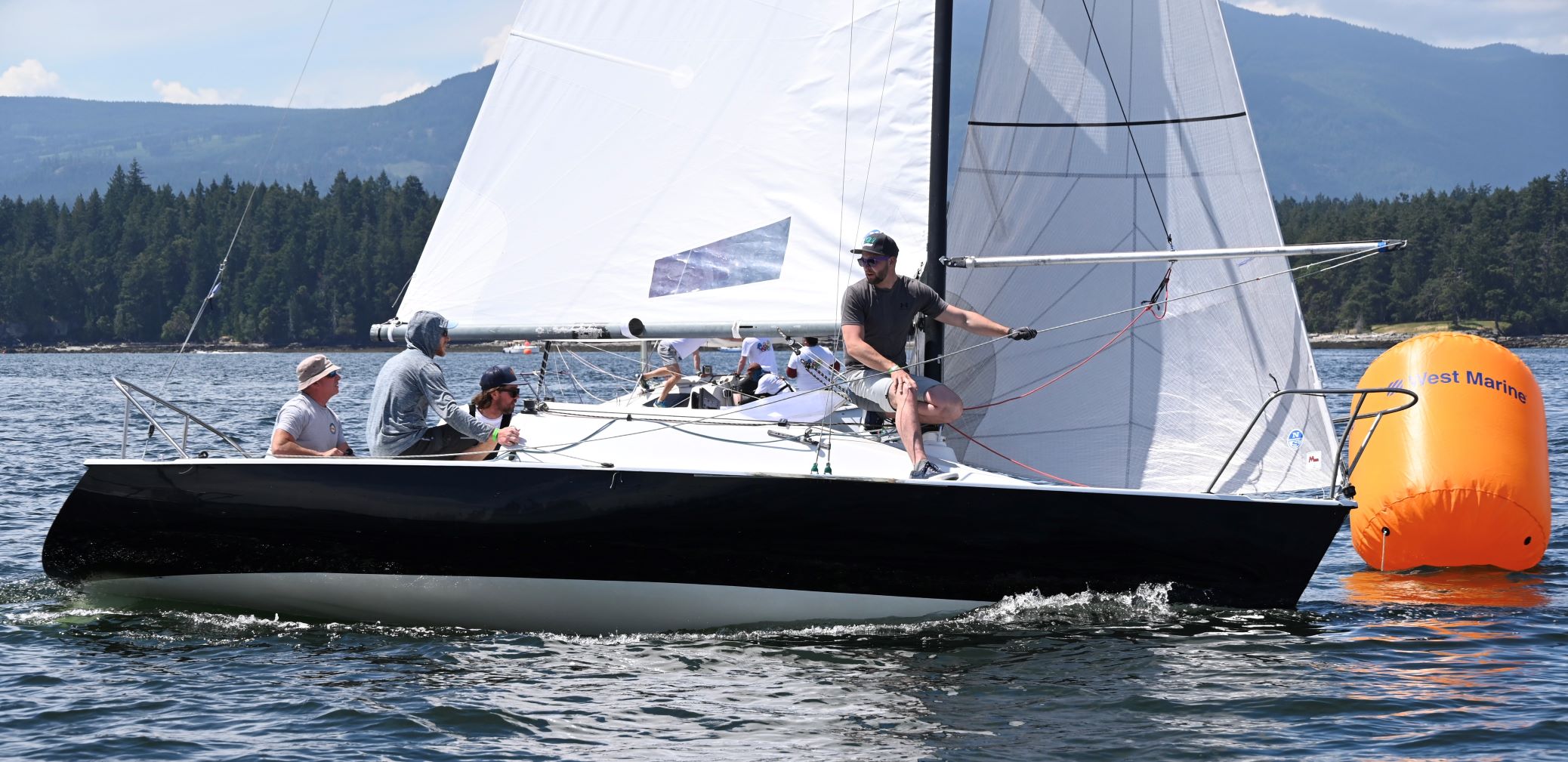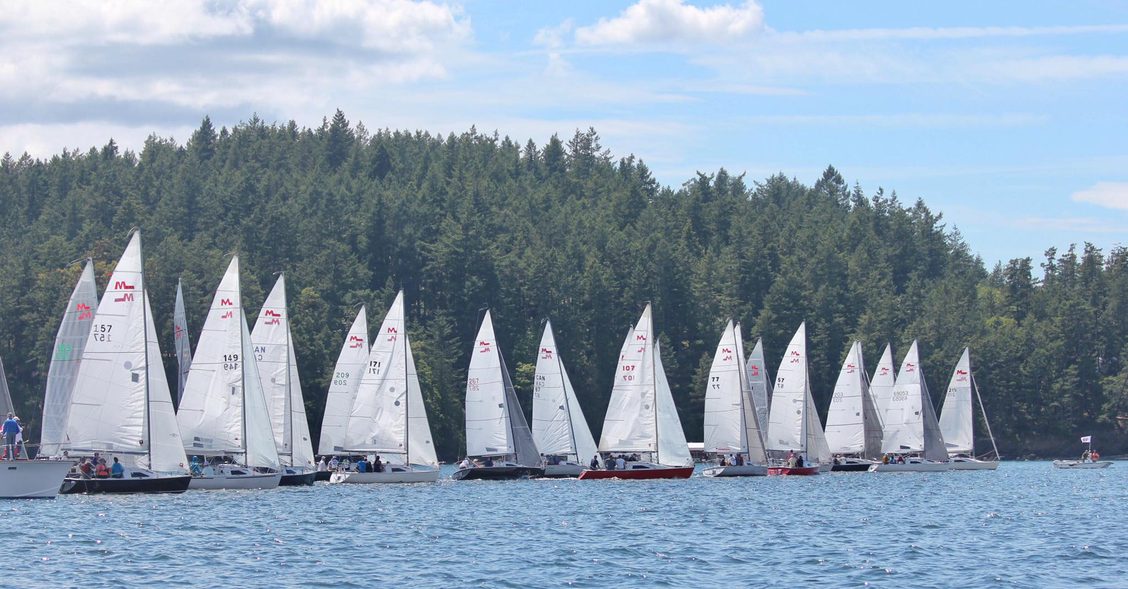2022 North Americans - Regatta Report
Pacific Yachting article from Alex Fox (thanks Alex!)
regatta report from Mike Clements (thanks Mike!)
The 2022 Martin 242 NA's were held in light air in Nanaimo with a fleet size of 15 boats. Many top Regional Teams attended the event, including 3-time winner Michael Clements, 2-time winner Alex Fox, runners-up Ken Holland and Matt Collingwood, and Phil Cragg & Reto Corfu, a top Vancouver team.

Team Too Wicked taking it down!

Crantini - leading after Day 1, Hearbreaker on Day 2!

Back in Black - in the hunt up to the final finish...

m&m - a few great finishes, snapping at the heels
Lots more photos of all the boats here:
Round Bowen 2022 - Race Report
Round Bowen Results - M242’s Dominate Once Again

Shadowfax crew picking up some Hardware! Allan (middle left) holding the brand new Fleet 1 Round Bowen Award (donated by Colin Potter) and Clare (right side).
Allan Strain reports:
"I would have won (overall) with an age allowance, and SPOG gives age allowance. (Editor's note: I guess we should lobby for a change to the scoring rules for next year?) It was light, patchy, and very shifty. Glad I got into wind first and left the fleet behind as we rounded to tight reach up south side of Bowen."
Nice job racers!

image credit: Stefan
May 2022 - Upcoming Events
Registration Update Regarding Major Upcoming Events
Pacific Coast Championship / Cal Race Week
The Regatta website is open here, the NOR is available, and the SI’s will be available soon. The event takes place on June 4 & 5. US$75 to Register until May 22, and US$150 after that. Five M242’s have Registered so far.
Round Bowen Race
The Regatta website is open here, the NOR is available, and the SI’s will be available soon. The event takes place on June 11. $60 to Register until June 1, and $65 after that. Social events on Friday & Saturday nights.
One M242 has Registered so far, and we are expecting up to 15 boats from Washington State and BC. Free overnight moorage on the Friday and Saturday nights is available for participants at Union Steamship Marina on specified docks. See the regatta website for details.
Round Orcas Race
The Regatta website is open here, the NOR & SI’s will be available soon, and the event takes place on June 18.
NA’s at Nanaimo
The 2022 NA’s in Nanaimo are approaching quickly on July 2/3, and 12 M242’s have Registered so far on the regatta website here, and we are expecting 25-30 boats from California, Washington State, BC, and Alberta. The world-renowned Opti races and Regatta Party take place on Friday evening after the M242 Practice race.
Registration deadline is May 27 to be eligible for the early bird prize draw!
A team from Los Angeles is looking for a M242 to borrow/charter, so if you have a good boat that you are not planning on racing in the NA’s with, please consider contacting Denise George at 1-310-490-9432 or This email address is being protected from spambots. You need JavaScript enabled to view it.
BC Championship at Gibsons
The Regatta website is open here, the NOR & SI’s are available, and the event takes place on July 23/24.
Two M242’s have Registered so far, and we are expecting up to 10 boats from BC.
Skippers are encouraged to make moorage reservations as soon as possible, as there is limited reserved space for competitors, and M242’s will be rafted 3-deep on one side of an 82’ concrete float, and motherships will be rafted in the main harbor. See the regatta website for details and contact info at Gibsons Landing Harbor Authority.
Cowichan Bay Regatta
The Regatta website is open here, the NOR is available, and the event takes place on July 30/31. 40% off Early Registration ends on June 1st, so don’t miss this great deal.
Four M242’s have Registered so far, and we are expecting up to 15 boats from Washington State and BC. Skippers are encouraged to make moorage reservations as soon as possible via the regatta website - see it for details.
REMINDER - All competitors need to have at least the helmsperson Registered with a Fleet for the NA’s, PCC’s, and BC Championships, plus the boat itself, per Class Rule 7, so to join Fleet 1 or Fleet 2 go to “Member & Boat Registration” at www.m242fleetone.org
Fleet 1 has 19 boats and 41 Members Registered so far (we usually peak at 28-30 boats and almost 70 Members) and Fleet 2 has 17 boats and 20 Members Registered so far, with about another 4-5+ to go in each category. See the complete list here.
Fleet One Association Article Count: 1
Page 33 of 72


